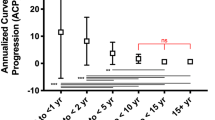Abstract
Study Design
Retrospective review.
Objectives
To evaluate the incidence of adolescent idiopathic scoliosis (AIS) curve progression and brace prescription in skeletally immature patients (Risser 0 to Risser 1) with curves 15°–24°.
Summary of Background Data
Many skeletally immature patients with mild AIS ask about the likelihood of curve progression. No studies have answered these questions.
Methods
The charts and radiographs of 302 consecutive patients with curves 15°–24° at initial visit, Risser 0 to Risser 1, were reviewed until skeletal maturity (≥Risser 4) or surgery. Curves averaged 19.1° ± 2.9° at initial visit. The Risser grade was 0 in 247 patients (82%) and 1 in 55 patients (18%). Patients who were Risser 0 were compared with those who were Risser 1, curves 15°–19° were compared with curves 20°–24°.
Results
The majority of patients demonstrated curve progression ≥5° (65%). Patients who were Risser 0 did not progress significantly more than patients who were Risser 1 (10° vs. 8°) (p = .22). Patients with curves 20°–24° did not progress significantly more than patients with curves 15°–19° (10° vs. 9°) (p = .65).
Conclusions
Curve progression for small curves (15°–19°) is similar to curves between 20° and 24°. Close observation or perhaps early intervention for these patients is necessary. These data may suggest a paradigm shift to earlier brace initiation and call for early treatment in small curves.
Level of Evidence
Level II.
Similar content being viewed by others
References
Lonstein JE, Carlson JM. The prediction of curve progression in untreated idiopathic scoliosis during growth. J Bone Joint Surg Am 1984;66:1061–71.
Bunnell WP. The natural history of idiopathic scoliosis. Clin Orthop Relat Res 1988;229:20–5.
Weinstein SL, Ponseti IV. Curve progression in idiopathic scoliosis. J Bone Joint Surg Am 1983;65:447–55.
Ylikoski M. Growth and progression of adolescent idiopathic scoliosis in girls. J Pediatr Orthop B 2005;14:320–4.
Peterson LE, Nachemson AL. Prediction of progression of the curve in girls who have adolescent idiopathic scoliosis of moderate severity. Logistic regression analysis based on data from the brace study of the scoliosis research society. J Bone Joint Surg Am 1995;77:823–7.
Little DG, Song KM, Katz D, et al. Relationship of peak height velocity to other maturity indicators in idiopathic scoliosis in girls. J Bone Joint Surg Am 2000;82:685–93.
Sanders JO, Browne RH, McConnell SJ, et al. Maturity assessment and curve progression in girls with idiopathic scoliosis. J Bone Joint Surg Am 2007;89:64–73.
Sanders JO, Herring JA, Browne RH. Posterior arthrodesis and instrumentation in the immature (Risser-grade-0) spine in idiopathic scoliosis. J Bone Joint Surg Am 1995;77:39–45.
Risser JC. The iliac apophysis: an invaluable sign in the management of scoliosis. Clin Orthop 1958;11:111–9.
Little DG, Sussman MD. The Risser sign: a critical analysis. J Pediatr Orthop 1994;14:569–75.
Biondi J, Weiner DS, Bethem D, et al. Correlation of Risser sign and bone age determination in adolescent idiopathic scoliosis. J Pediatr Orthop 1985;5:697–701.
Weinstein SL, Dolan LA, Cheng JC, et al. Adolescent idiopathic scoliosis. Lancet 2008;371:1527–37.
Karol LA, Virostek D, Felton K, et al. The effect of the Risser stage on bracing outcome in adolescent idiopathic scoliosis. J Bone Joint Surg Am 2016;98:1253–9.
Katz DE, Herring JA, Browne RH, et al. Brace wear control of curve progression in adolescent idiopathic scoliosis. J Bone Joint Surg Am 2010;92:1343–52.
Lenke LG, Edwards 2nd CC, Bridwell KH. The Lenke classification of adolescent idiopathic scoliosis: how it organizes curve patterns as a template to perform selective fusions of the spine. Spine (Phila Pa 1976) 2003;28:S199–207.
Monticone M, Ambrosini E, Cazzaniga D, et al. Active self-correction and task-oriented exercises reduce spinal deformity and improve quality of life in subjects with mild adolescent idiopathic scoliosis. Results of a randomised controlled trial. Eur Spine J 2014;23:1204–14.
Anwer S, Alghadir A, Shaphe A, et al. Effects of exercise on spinal deformities and quality of life in patients with adolescent idiopathic scoliosis. Biomed Res Int 2015;2015:123848.
Zapata K, Sucato D, Jo C. Physiotherapeutic scoliosis-specific exercises may reduce curve progression in mild adolescent idiopathic scoliosis curves. Ped Phys Ther 2019;31:280–5.
Weinstein SL, Dolan LA, Wright JG, et al. Effects of bracing in adolescents with idiopathic scoliosis. N Engl J Med 2013;369:1512–21.
Charles YP, Dimeglio A, Canavese F, et al. Skeletal age assessment from the olecranon for idiopathic scoliosis at Risser grade 0. J Bone Joint Surg Am 2007;89:2737–44.
Sanders JO, Khoury JG, Kishan S, et al. Predicting scoliosis progression from skeletal maturity: a simplified classification during adolescence. J Bone Joint Surg Am 2008;90:540–53.
Author information
Authors and Affiliations
Corresponding author
Additional information
Author disclosures: KAZ (none), DJS (a patent Globus with royalties paid), MCL (grants from Scoliosis Research Society, other from JBJS Classroom, outside the submitted work), CHJ (none).
IRB approval: Institutional review board approval was received from Texas Scottish Rite Hospital for Children and University of Texas Southwestern.
No funding was received from this work.
Rights and permissions
About this article
Cite this article
Zapata, K.A., Sucato, D.J., Lee, M.C. et al. Skeletally Immature Patients With Adolescent Idiopathic Scoliosis Curves 15°–24° Are at High Risk for Progression. Spine Deform 7, 870–874 (2019). https://doi.org/10.1016/j.jspd.2019.02.012
Received:
Revised:
Accepted:
Published:
Issue Date:
DOI: https://doi.org/10.1016/j.jspd.2019.02.012




